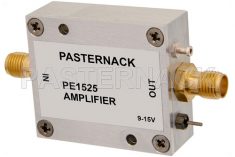 At first look, there are many different types of RF amplifiers, and it could be overwhelming to go from the specs you need to narrowing down what RF amplifier type is the best fit. Most RF amplifier types came about from the specification requirements of common transceiver, receiver, transmitter, radar, and modulation circuits and system-level typologies. The following is a brief overview of the purpose of these amplifiers, with insights into the applications they may be a good fit for.
At first look, there are many different types of RF amplifiers, and it could be overwhelming to go from the specs you need to narrowing down what RF amplifier type is the best fit. Most RF amplifier types came about from the specification requirements of common transceiver, receiver, transmitter, radar, and modulation circuits and system-level typologies. The following is a brief overview of the purpose of these amplifiers, with insights into the applications they may be a good fit for.
Broadband Amplifiers
Broadband amplifiers, or wideband amplifiers, are designed to offer moderate gain over a wide bandwidth, while maintaining a low noise figure. These types of amplifiers are often used within receiver circuitry at the front-end of the antenna, when low noise amplifiers aren’t required, and within a receiver where additional gain is needed and noise is a concern.
Gain Block Amplifiers
Gain block amplifiers, or gain blocks, are similar to broadband amplifiers, with the exception that they typically aren’t designed for as low of a noise figure and have greater gain than broadband amplifiers. Gain block amplifiers are used in IF, RF, and microwave transmitter applications, and may include models with narrow bandwidths or wide bandwidths. This typically depends on the types of applications they are designed for.
Log Amplifiers
A log amplifier is an amplifier that exhibits a gain curve where the output voltage is a multiple of the natural log of the input voltage. This type of amplifier is specifically used in applications that require this behavior.
Variable Gain Amplifiers
Variable gain amplifiers are a type of amplifier with a controllable, and sometimes programmable, gain. This can be done through the use of variable gain circuits, or variable attenuators and a fixed gain amplifier, depending on the application. Also known as linear-to-logarithmic converters, these amplifiers are often used as part of a closed-loop control circuit to maintain a consistent signal power level of the main signal path.
Low Noise Amplifiers
Low noise amplifiers leverage any portion of a transmitter or receiver design where a low power signal needs to be amplified to a working power level without introducing significant noise or phase noise. This could be at the output of an oscillator, strengthening a signal to drive a mixer, or at the input of an antenna to increase a signal’s power enough to be easily processing by demodulation and digitization circuitry.
Coaxial and Waveguide Power Amplifiers
Power amplifiers are the workhorse amplifiers in the RF front-end of transmitters, which convert the small power signals from communications and radar equipment to high powered transmissions sent to an antenna. The goal of a power amplifier is to increase the gain of a signal to a high power level, without reducing the quality of the signal. As this is typically a hard design challenge with many tradeoffs, certain power amplifiers may be optimized for parameters that best fit the pulsed radar, CW radar, digital communications, or other application for which they are required.
Power amplifiers must also contend with handling various types of loads, some of which could cause damaging reflections. Hence, power amplifier designs commonly include protective circuitry. Power amplifiers could leverage coaxial connectors, or even waveguide connectors if the power level is high enough or the frequency of operation is high enough.
Learn more, here {http://blog.pasternack.com/active-components/rf-amplifiers-active-components/rf-amplifier-packaging-thermal-dynamics/}
And here {http://blog.pasternack.com/rf-amplifiers/rf-amplifier-power-gain-considerations/}
Linear Amplifiers
A linear amplifier is typically a type of RF power amplifier, which is specifically designed to provide highly linear performance, with the input and output maintaining a proportional linear relationship. Hence, linear amplifiers are designed to optimize linearity over other design considerations, especially under a wide range of load conditions. Linear amplifiers are most often used in transmitters and test equipment where high linear power is required.
Bi-directional Amplifiers
Bi-directional amplifiers are a combination of both a transmitter and a receiver, designed for the purpose of acting as an intermediate node receiving a weak signal and amplifying that signal for retransmission and capture at an electrically distant location. Bi-directional amplifiers are often used to extend communications networks to remote locations without having to install additional infrastructure. This could be for covering larger overland areas, or used with coaxial transmission lines to extend a signal or communication system longer distances underground or within facilities. Bi-directional amplifiers usually require good performance low-noise amplifiers and power amplifiers. With models that handle high throughput digital communications, the necessary demodulation and modulation circuitry may be included in a bi-directional amplifier to completely recreate and retransmit a signal to ensure the highest fidelity at the destination.
Learn more, here {http://blog.pasternack.com/uncategorized/constraints-considerations-bi-directional-amplifiers/}
Hi-Rel Amplifiers
Hi-Rel amplifiers are a class of amplifiers that meet, or exceed, a high reliability standard or expectation, typically for automotive, aerospace, space, or military/defense applications. These amplifiers are often more resilient than their standard counterparts, and have ratings that include the likely lifespan of the amplifier under a variety of operational conditions.
Learn more, here {http://blog.pasternack.com/uncategorized/whats-hype-high-reliability-hi-rel/}




 Pasternack Blog
Pasternack Blog
